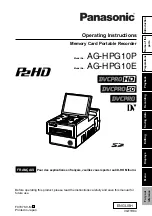
Page 14 of 32
V1682OPMA.doc
17 February, 2005
4. MAKING MEASUREMENTS
4.1 I
NTRODUCTION
The V1682 VALID reader, when fed with video and audio signals from the V1681 VALID generator,
has the capability to measure audio delay relative to video, audio level, and will identify the channel
cross-overs, L/R swaps, and channel inversions. The time-marked video signal from the V1681 is
rugged enough to pass unscathed through almost any video processing or transport medium,
including ARCs, standards converters, compression links, noise reducers and noisy satellite links.
4.2 V
IDEO
I
NPUT
The V1682 accepts a CCIR601 SDI input through on of its two** inputs. Selection of the video input
is done under the
VID OSD > SDI Src
menu option. If only one input is available, this control is not
adjustable.
In order to make correct timing measurements, the input video must contain a continuous signal
from a V1681 VALID generator. The V1682 is capable of making timing measurements even when
the video from the V1681 has been reduced to any size down to ¼ screen, with any additional
stationary content in the picture, as long as all but the VALID test signal is stationary (Figure 4.1a).
The VALID system will NOT work correctly if any significant movement has been superimposed
picture received by the V1682, but stationary captions / logos are allowed (Figure 4.1b).
The system is not dependent on background test pattern, so any of the test patterns generated by
the V1681 generator are suitable for measurements (e.g. Figure 4.1d), except for the pluge signal
which may give unreliable results due to the low luminance level.
The system is also tolerant of very low signal levels (as low as –12dB), and high levels of noise.
The VALID system Is designed to work through cross-standards, so even if the generator is working
in a 625 line format, the receiver will measure correctly after standard conversion to 525 (or vica-
versa).
** The second SDI input is optional and only available with the correct link settings, see Sec 2.5.2 .
(a)
(b)
(d)
(c)
Figure 4.1 – Examples of acceptable VALID test signals















































